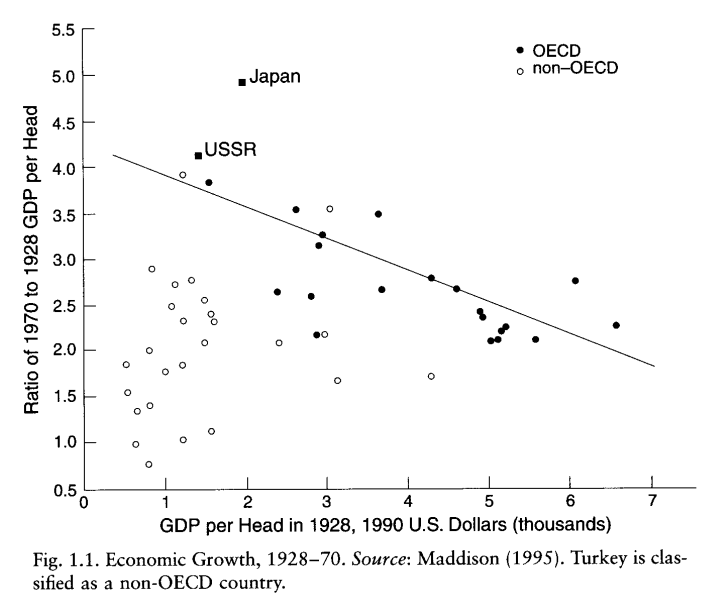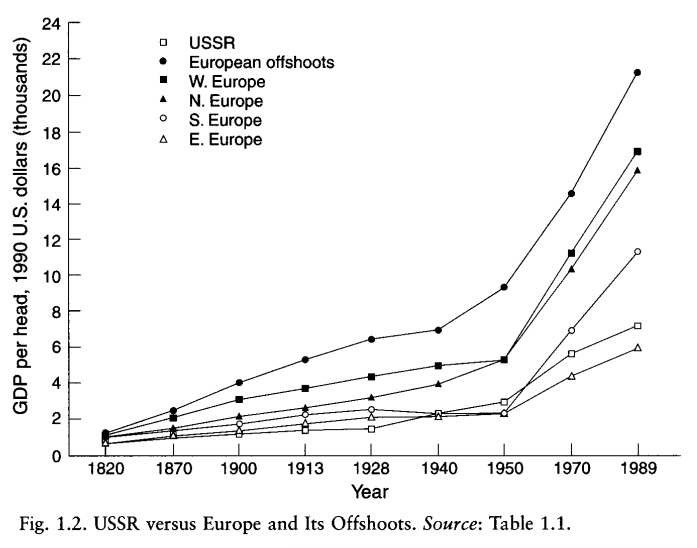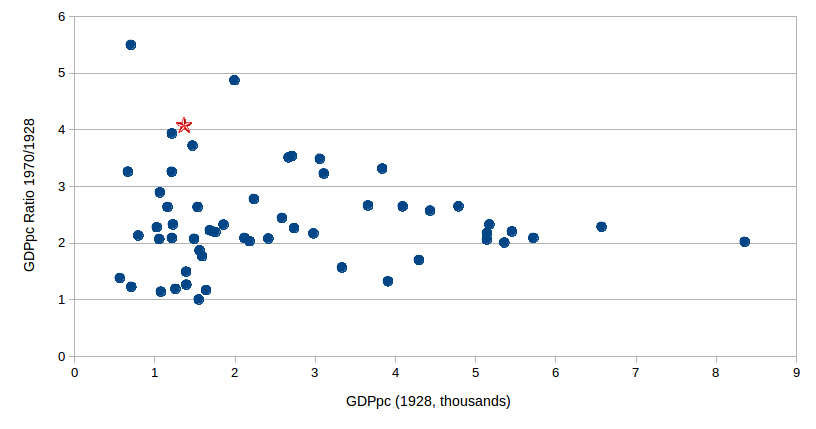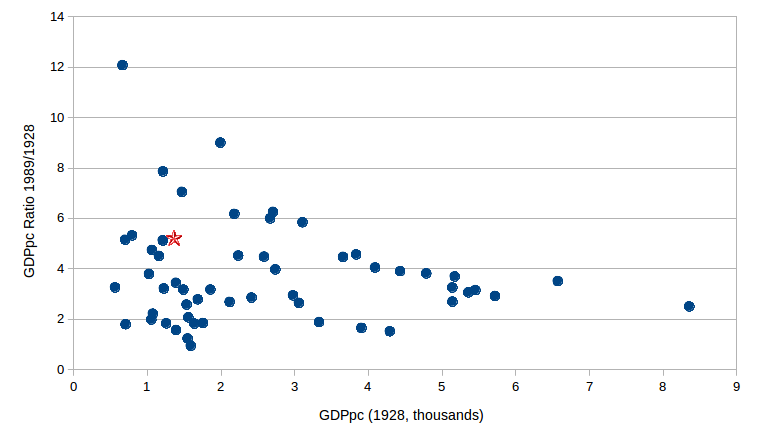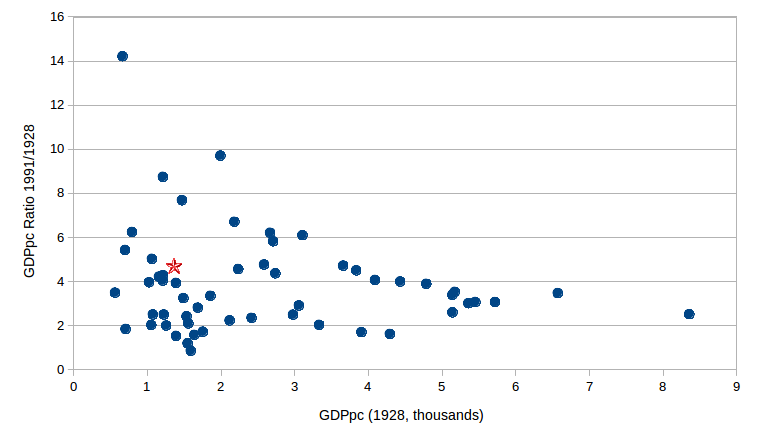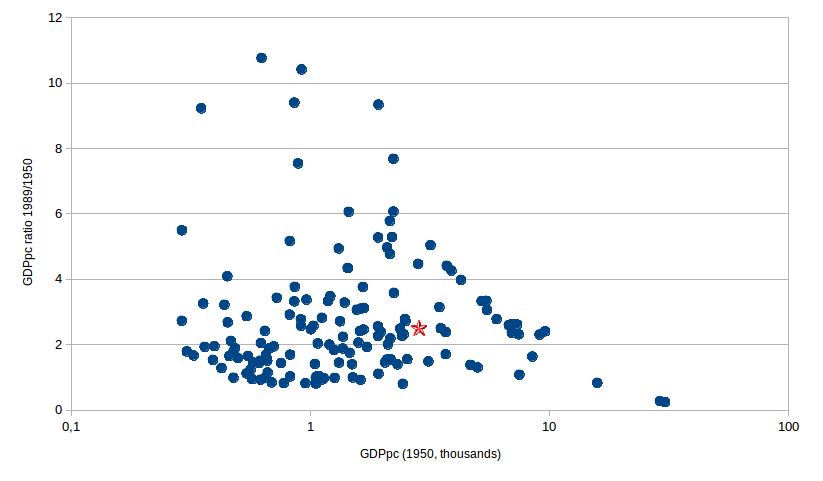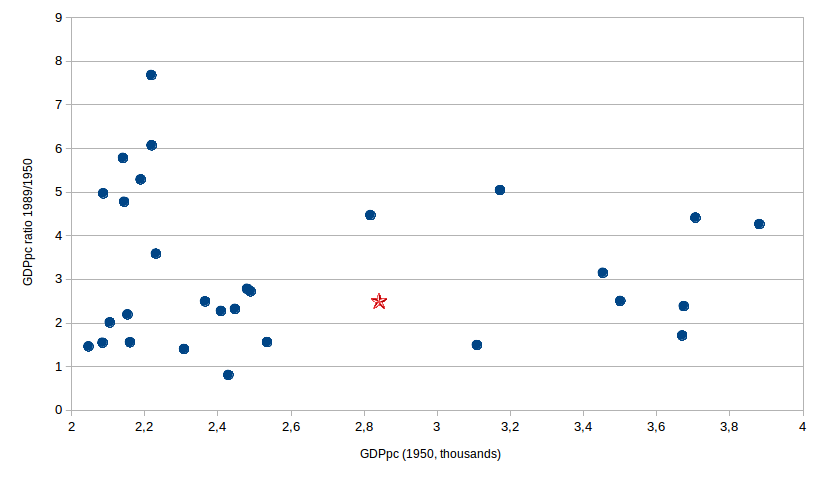The Soviet Union: GDP growth
[Part of the Soviet Union series]
Some data on soviet GDP growth. First, the chart many supporters of the USSR like. It supposedly shows that the soviet economy worked relatively well, and that industrialisation and growth were due precisely to central planning, when the Soviet Union was formed, in 1922, after the revolution in 1917.

We can then compare the Soviet Union to the United States

The USSR never did really compete in the same league as the US, and the gap between the two didn't became narrower after the USSR began, even when taking into account that poorer countries tend to grow faster when they industrialise.
We can then compare the USSR with other countries that had similar incomes in 1930. The USSR doesn't do particularly well in this metric. Initially it did better than many countries, but by the 70s it was being outpaced by the rest. By 1990, the average income in the USSR matched that of Malaysia, below countries like Spain and Portugal.
The USSR could be seen as a long-term bubble economy: Initial fast-growth, then stagnation, and finally crisis, in comparison to the rest of the economies, that took longer to take off, but that growth was then sustained.

We can also take another year, like 1950, to avoid WWII effects, and use indexed data, but this doesn't change the picture much. That's why I included fewer countries, to make my life easier. I also included the United States and Switzerland and Hong Kong. Hong Kong tells roughly the same story as Singapore: that you can be really poor and grow rich with adequate institutions and capitalism. The United States and Switzerland (Or any developed country) illustrate an effect that wasn't obvious from the previous charts: that it isn't fair to compare the rates of growth between these countries and the SU. Richer countries grow at a slower pace.
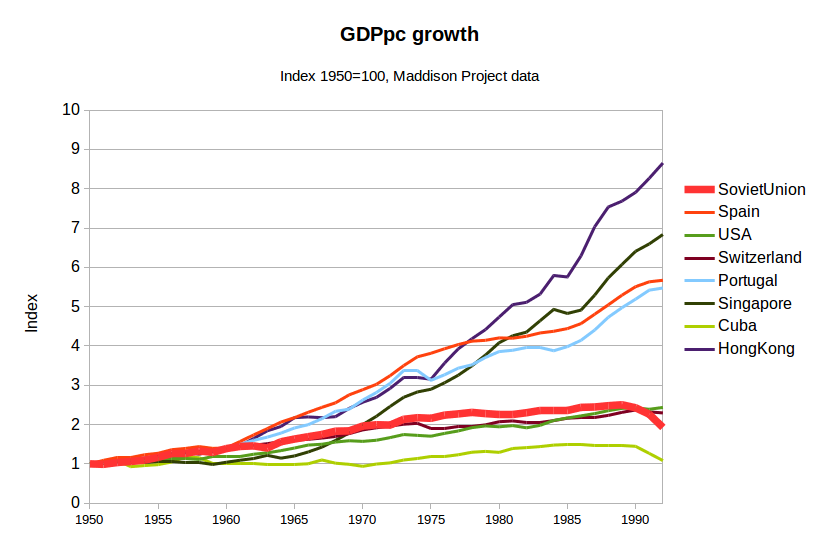
Given this data, the Soviet Union was the mediocre economy economists say it was, not a healthy, growing, superpower. If the USSR had an impact in the world, it was due to its size, natural resources, population, and strong military, not because it was more productive than other countries.
And in case you were wondering about Cuba, here's the data for Cuba and some countries in its surroundings. I have a post about Cuba here, in Spanish.
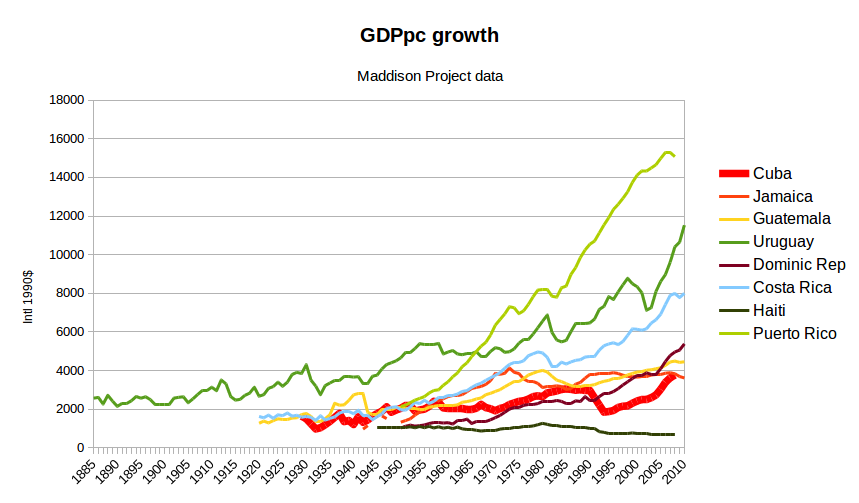
Against these charts, it could be argued that these measures of GDP don't really capture the welfare of the inhabitants of these countries. Fair enough, we could then study those other indicators and examine quality of life in a different way. But it has to be granted that by this measure, the best (argueably) centrally planned economy did not outperform the best free market economies.
To finish, the Stalin question. Did Stalin help industrialise Russia? Would Russia be a poor agrarian country without his policies?
No, say economists Cheremukhin, Golosov,Guriev, and Tsyvinski (2013)
Therefore our answer to the ‘Was Stalin Necessary?’ question is a definite ‘no’. Even though we do not consider the human tragedy of famine, repression and terror, and focus on economic outcomes alone, and even when we make assumptions that are biased in Stalin’s favour, his economic policies underperform the counterfactual. We believe Stalin’s industrialisation should not be used as a success story in development economics, and should instead be studied as an example where brutal reallocation resulted in lower productivity and lower social welfare.
(Edit) But wait! What about Robert Allen's From Farm to Factory? What if we consider the USSR starting with Stalin (1928).
Then we find that from 1928-1970, the USSR was the fastest growing economy except for Japan!
And even compared to the Third World, its performance was remarkable,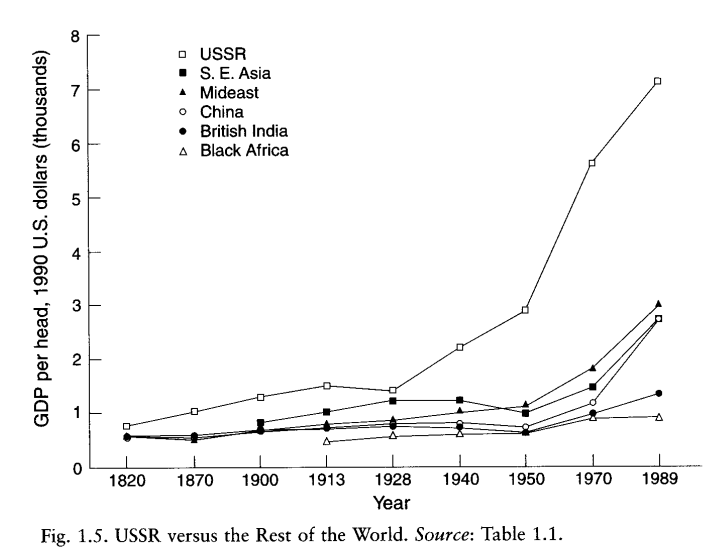
Allen uses Maddison (1995) data for his charts. The Maddison Project has updated data, so I first attempt to replicate his Figure 1.1.
The little red star is the USSR, of course. So Allen's chart is correct. In mine, Jamaica appears as the top performer, and Japan comes as second. The USSR was the third fastest growing economy in the world in the 1928-1970 period (Including countries for which we have 1928 data).
Next, I consider the period 1928-1989 and 1928-1991. Allen stops at 1970 because until then 'the planning system was working well'. In my view, we should see what came after 1970 as a consequence of what came before, including perhaps the breakup and crash of the Soviet economy in 1991. Stopping our analysis when the planning system stopped working well seems to me like stopping an analysis of the Spanish economy just when the housing bubble was about to pop. By this I mean that Soviet growth was propelled in great measure by increasing inputs (capital and labour), not productivity, and that is not a stable long-term run strategy. At some point you run out of people to put to work. I refer to you to this other post of mine for more info on this. This is not an speculation of mine, it is the consensus view of why the USSR ended up stagnating (Though this by itself did not cause its collapse).
Now, the USSR is below South Korea, Japan, Taiwan, Portugal, Finland, Singapore, Italy, Norway, and Thailand.
When extended to 1991, the USSR is also overtaken by Spain, Jamaica, and Singapore
But still, it's not that bad, certainly better than my charts above suggest. Spain doesn't appear in the 1928-1989 chart because of the 1936-39 civil war.
Let us now consider one final chart: 1950-1989. Here we have data for far more countries, and we avoid the effect of WWII. The Soviet Union was here the 61th out of 148 economies in growth. Still in the upper 50%!
Zooming in near the USSR,
(Edit2)
Yet another way of looking at this is expressing GDP per capita as a fraction of US GDP per capita. Doing that we get this chart:
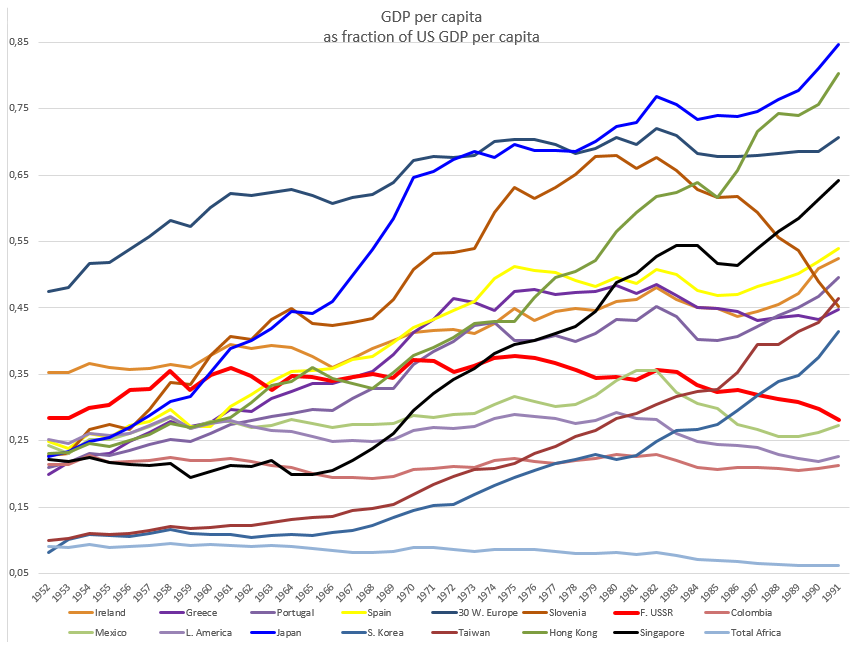
I included countries already chosen in previous charts, plus averages for Africa, Latin America and Western Europe. In 1952, the Soviet Union was only behind Ireland and Western Europe as a whole. By 1975, when the USSR reached its maximum, it had a higher GDP per capita than Mexico, Latin America, Colombia, South Korea, Taiwan, and Africa.
By the end of 1991 (just before the fall), it had about the same GDP per capita as Mexico.
(Edit3)
A chart with growth rates for the Soviet Union and the Former Soviet Union (basically, Russia). I see the Brezhnevian stagnation (Under Brezhnev, Andropov, Chernenko and Gorbachev, as the Perestroika did little to change the trend) as a followup from previous policies to Stalin-Khrushchev. So it's dubious that such growth rates could have continued indefinitely. We must also note that the FSU is recovering from a crisis, which makes easier to have larger growth rates.
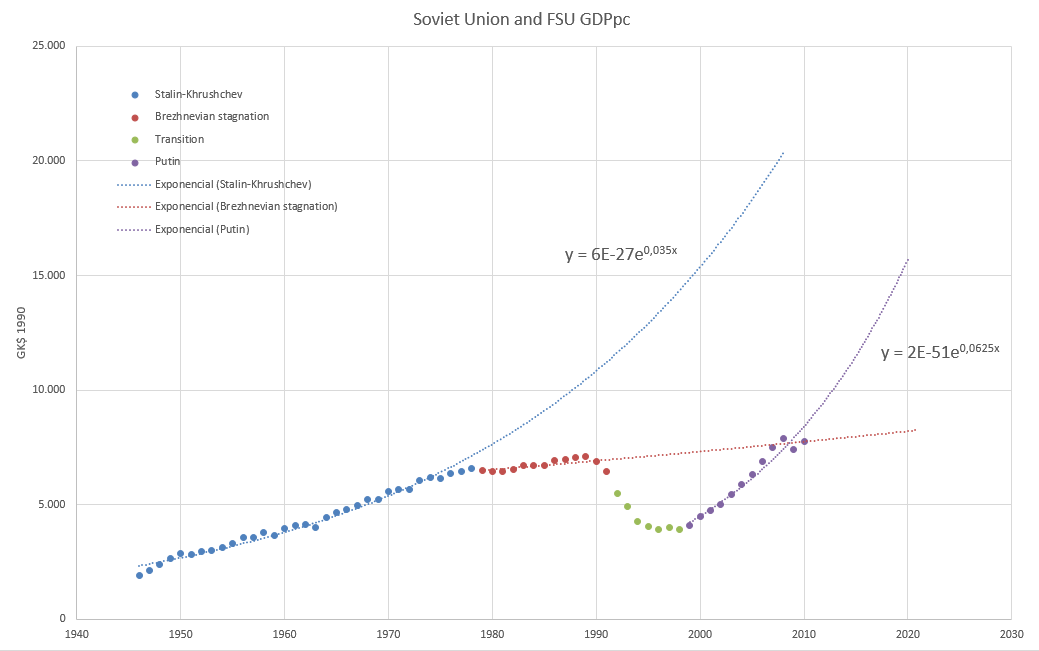
(Edit4)
The analysis above may need some further reconsideration. The charts presented until now are controlling just for initial GDP. But Easterly & Fischer (1995) run a regression for the 1960-1989 period, controlling for variables such as initial GDP, share of investment, and secondary school enrollment. GDP growth for the Soviet Union in that period was 2.36% vs 2.00% for the West. But when controlling for those variables, the predicted growth for the Soviet Union jumps to 4.7%. Meaning that the economic system itself reduced growth in -2.34 points. (The value for the West does not change). In the 1950s, however, Easterly & Fischer do find that the Soviet system performed well in terms of growth. They ultimately explain this by what the dub the _extensive growth hypothesis: _Growth fueled by increasing the amount of available factors (Labour and Capital) rather than increasing productivity. That, combined with a low elasticity of capital-labour substitution (Using a CES production function, they get 0.4) meant that diminishing returns to capital would ultimately stall growth when the capital share of the economy began to reduce as the economy shifted to consumer goods.
(Edit 5. And hopefully the last one!)
An analysis of Allen's book can be found here
Conclusion
The USSR did grow quite fast under Stalin. The question would then be to explain why did it grow so fast, why did it stagnate, and why Cheremukhin, Golosov et al. find that it wasn't because of Stalin, while Allen finds the opposite (I'll write a followup post explaining that). However, if we consider the Soviet Union starting with Stalin and ending in 1989, its performance was not as good. Furthermore, if we consider the post-WWII performance of the Soviet Union in comparison to other countries, it shows signs of stagnation. We can then say that the impressive growth of the Soviet Union was a one-off event, produced by Stalin's industrial policies. The USSR, however, wasn't able to sustain this growth rate.
Furthermore we would also have to examine other countries with central planning to see if the Soviet model was replicated, or if the performance of the Soviet economy was also due to specific factors present in Russia but not elsewhere. Note also that the Soviet Union spent a sizable share of its economy (15-17%) on military spending (vs 5% in the US in the 80s) and on investment (rather than consumption), so GDP growth does not translate into population welfare equally in every country. This could be read to mean that the USSR would have done even better had it spent less on the military. Or, conversely, that its GDP did that good because of it, if it's easier to grow an economy oriented to produce T-72s and MiG-29s than consumer goods. As you can see in my other posts, healthcare, food consumption, and working conditions were not as good as this GDP comparison might suggest.
Bonus link: USA vs USSR industrial capacity
References
Cheremukhin, A., Golosov, M., Guriev, S., & Tsyvinski, A. (2013). Was Stalin Necessary for Russia's Economic Development? (No. w19425). National Bureau of Economic Research.
Easterly, W., & Fischer, S. (1995). The Soviet economic decline. The World Bank Economic Review, 9(3), 341-371.
The Maddison-Project, http://www.ggdc.net/maddison/maddison-project/home.htm, 2013 version.
Comments from WordPress
- The Soviet Union: Healthcare | Nintil 2016-03-29T19:49:35Z
[…] a previous post, I talked about Soviet GDP growth. In this post, I will discuss the healthcare system in the Soviet […]
- The Soviet Union series | Nintil 2016-05-14T15:56:55Z
[…] The Soviet Union: GDP growth […]
Alex 2016-05-01T02:32:25Z
You can't measure GDP in a non-market economy, by definition they're not using the prie mechanism to determine production, so you can't just invent one to quantify their GDP - that would make you a central planner just as much as the people that ran the Communist economies.
Artir 2016-05-01T09:09:23Z
Here's how it's done http://www.ggdc.net/maddison./ARTICLES/USSR,RIW,1998.pdf If you wanted to compare using, e.g. raw production (cars, potatoes, sewing machines, etc. produced, adjusted for quality) you could. There's data for that. But the picture doesn't change much.
- Three most interesting articles of the day (May 31) | BAIL: Bay Area International Link 2016-05-31T03:08:59Z
[…] The Soviet Union: GDP growth (Nintil) […]
Miguel 2016-07-09T01:43:49Z
Hola, gran post, te felicito.
Me gustaría saber como hiciste el grafico del crecimiento del pib per capita relativo a 1950 donde aparece la Urss con España y Portugal.
Gracias
Artir 2016-07-09T09:44:27Z
Dividí los PIBs de cada país por el PIB que tenían en 1950, no tiene nada de especial.
Welsh Learners / Dysgwyr Cymraeg 2017-01-24T07:11:21Z
As someone who feels ideologically homeless, I dont understand why we judge the quality of countries based on GDP alone.........infinite growth on a finite planet is unsustainable.............maybe lower growth rates do not have to equate to lower levels of research and innovation (new inventions)
Also you have missed something out badly...............comparisons with how sharply technological advancement is now taking place.
No wonder the world is growing stronger and stronger when the rate of technological advancement has entered a logarithmic curve.
Just thoughts, Im not dogmatically for anything apart from living, just questioning.
Humans barely scratch whats knowable or possible in the universe currently
- The Soviet Union: Productive Efficiency | Nintil 2016-11-07T21:49:57Z
[…] paper first analyses growth (something I also did here, updated with their conclusions), and find it wanting once usual suspects (initial GDP, population […]
Julian 2016-12-22T21:21:16Z
From what I recall, didn't the Eastern Bloc use net material product (NMP; basically GDP minus "non-productive" services) instead of GDP to estimate national income? I've seen a lot of pro-communist sources make claims for COMECON growth (especially compared to Western growth) that don't seem to match up with GDP numbers; I'm guessing they were using NMP instead (at least for the Eastern Bloc; I wouldn't be too surprised if at least a few of them were still using GDP numbers for the West). I'm wondering if there are actually any sources available which let you calculate and compare actual (as in, not distorted by the government) NMP numbers for both sides of the Iron Curtain (plus the USA); I'm curious to see how the West matches up with the East at their own game.
Julian 2016-12-22T21:49:05Z
It probably goes without saying, but I meant NMP per capita.
sinekonata 2017-03-29T23:44:36Z
Since I know a bit of the USSR's history I have a different approach to your conclusion that the growth was a one-off event. It would need more attention to dates and details to verify this but my explanation for the different rates of GDP growth is that starting from Khrushchev onwards the USSR's economy was "liberated" as in less centralized and more opened to the market. Gradually but surely. This resulted in an economic crisis around the time of Gorbachev that fuelled the dissolution of the USSR.
If you think about it, there is no reason to expect the industrialization of a country to ever be considered "done" until you have full automation of all work. So in a planned economy, which it was under Stalin, there is no reason to expect industrialization to end unless it's specifically decided by the people (or Stalin if you believe he decided everything), and why would they? So GDP growth, I expect, should have kept a steady pace. Not the same as pre-war since there is no impending war in sight but still a steady pace.
Finally, I believe that to truly illustrate the insane growth of the USSR (at least before the Khrushchevs) one should look at the state of non-USSR Russia at its peak (1913 I believe) and compare it to that which became of it. If you consider that period of history which we Leninists label the non-revisionist period of the USSR, there is no greater economic boom in modern history (despite the 3 wars).
The boom which might have made the USSR the #1 economy today had it kept going at its pre-Khrushchev's pace. To verify this is why I ended up on this post btw, I was wondering how the extrapolation of those figures would translate into today's world economy.
Artir 2017-03-30T10:13:48Z
Thank you for your comment, Sinekonata.
The explanation that you point out has come up a few times in my reading of the literature, but as I've been mostly focusing on macro-trends, I have not really dedicated time to study them. If one accepts that the slowdown in the USSR was due to decreasing returns to capital, or decreased productivity, etc, one can still ask why that happened, and indeed it could be that it was the decentralisation under Khruschev and Gorbachev. Some people go as far as saying that this slowdown caused the collapse of the USSR, but I would disagree with that, as I see the collapse as an evitable event, a result of Gorbachev's mishandling of the late USSR internal political crisis. But I still see that stagnation would have been hard to reverse.
About industrialisation, the issue is that you have to decide to allocate resources to consumption or investment (for further industrialisation). Stalin's massive investment in heavy industry ended up setting the base for the consumption industries. But then, at some point, one has to enjoy the fruits of that hard labor and long term investment. Post-Stalin USSR dedicated more resources to consumption and less to capital goods. This is not necessarily bad: it means people can enjoy more things, but it means they will enjoy less things in the future than otherwise they would have.
In your last paragraph you mention the counterfactual of pre vs post revolutionary Russia. Robert Allen did work on that counterfactual, including extending Lenin's NEP rather than having Stalinism (Is this what you had in mind with the non-revisionist period?) and I have a post up on that https://nintil.com/2017/02/04/the-soviet-series-from-farm-to-factory-stalins-industrial-revolution/ .
I guess it would be of interest for me to write another post (I keep wanting to finish writing about the USSR but I keep being drawn in :p) about the micro-causes of the stagnation and ultimate demise of the USSR, but first I want to blog about different things.
- Annual reviews and other Soviet business practices – Money, Power, and Culture 2016-12-13T11:03:51Z
[…] – where state planners didn’t massively push students towards STEM fields – was much more prosperous when the Soviet Empire crumbled. It is almost as if STEM shortages are mostly made up to keep wages […]
- The Soviet Series: From farm to factory. Stalin’s Industrial Revolution | Nintil 2017-02-04T19:37:55Z
[…] a previous entry in The Soviet Series, I made some remarks regarding GDP growth. You can see them here. I made a few more plots to complement the ones there, including some sensitivity analysis for […]
Yuri 2017-07-14T07:07:35Z
Oh and one last thing. While Stalin's industrialization was terribly cruel and not very efficient it was above all fast. The second great war was looming on the horizon and Stalin's quick industrialization is credited with allowing the USSR to stand up to the Germans. He is the savior of the country because he beat the Germans, not because he grew the economy.
Also it would be interesting to see PPP graphs included in the article. Price controls had an important impact on life in the USSR.
Alfonso 2017-06-30T18:16:13Z
Very interesting. Could you explain me how did you estimate the hypothetical trajectories of economic growth for each government showed in the last chart? thank you beforehand.
Yuri 2017-07-14T07:04:07Z
To me at least, economic growth was not the eastern blocs selling point. In fact a low but steady level of growth is one of the attractive things. Life is still good but growth is not so high as to necessitate pointless waste, nor to run headlong into some sort of horrible resource cap or environmental cliff. Life is reliable, stable and relatively comfortable; but not so comfortable that you start to live for comfort.
That aside, this is an informative article. Lots of charts. But it is hard to view the economics of a state in a vacuum affected only be economic policies of that state. Geopolitical policies (such as over-investment in the military over quality of life or over-investment in supporting foreign states and trying to sell the brand) greatly if not overwhelmingly impact a state's economic performance. Especially one where the economy is more in the hands of the executive rather than less.
- ¿Fue la Revolución Rusa un éxito económico? – Juan Ramón rallo | elcato.org – Verdades Ofenden 2017-11-29T21:45:27Z
[…] definitiva, el crecimiento de la URSS no tuvo nada de excepcional ni comparado con las tendencias que ya se estaban experimentando internamente antes de la […]
- ¿Fue la Revolución rusa un éxito económico? - Economía y Libertad 2017-12-10T15:21:09Z
[…] definitiva, el crecimiento de la URSS no tuvo nada de excepcional ni comparado con las tendencias que ya se estaban experimentando internamente antes de la […]
Citation
In academic work, please cite this essay as:
Ricón, José Luis, “The Soviet Union: GDP growth”, Nintil (2016-03-26), available at https://nintil.com/the-soviet-union-gdp-growth/.
